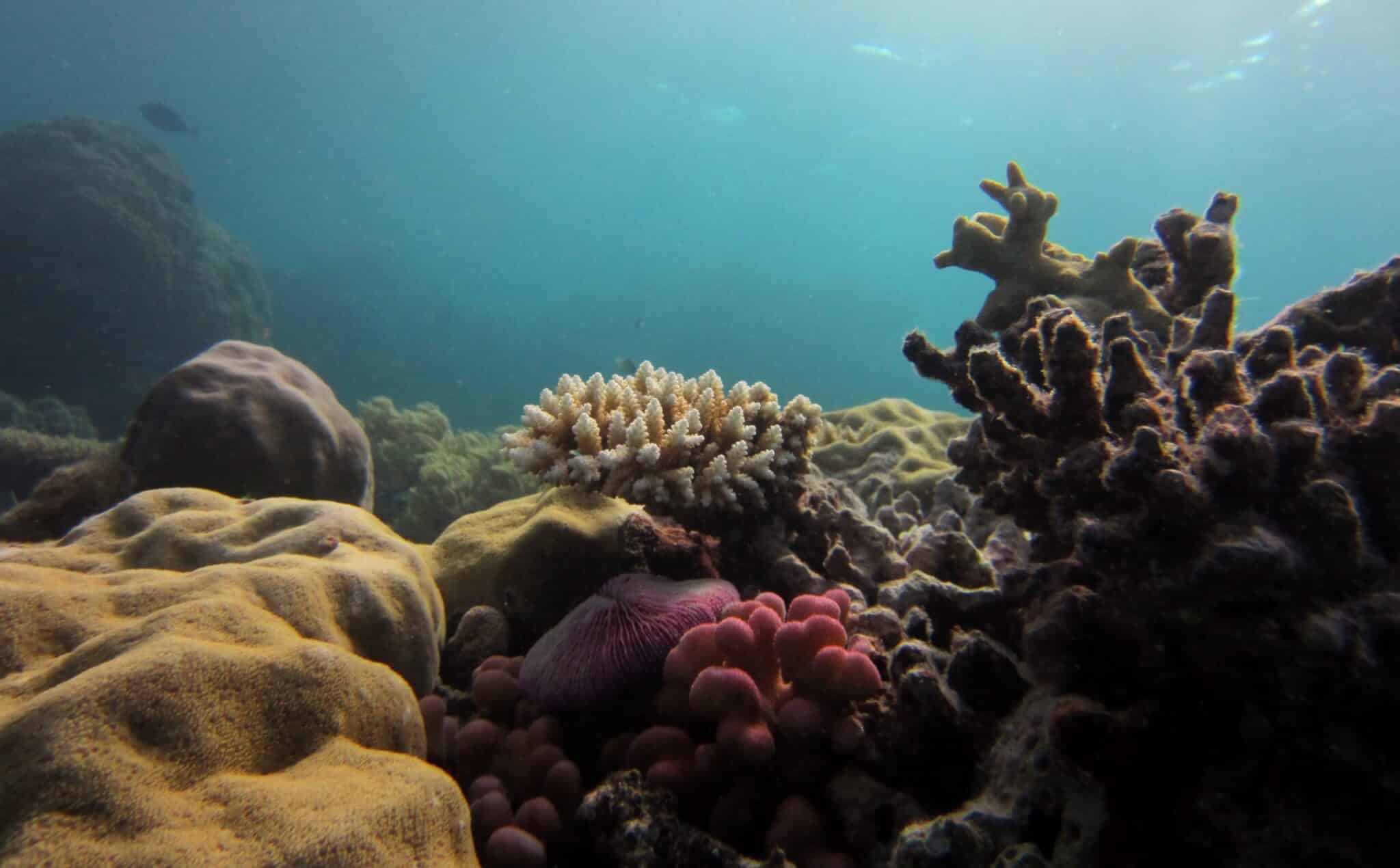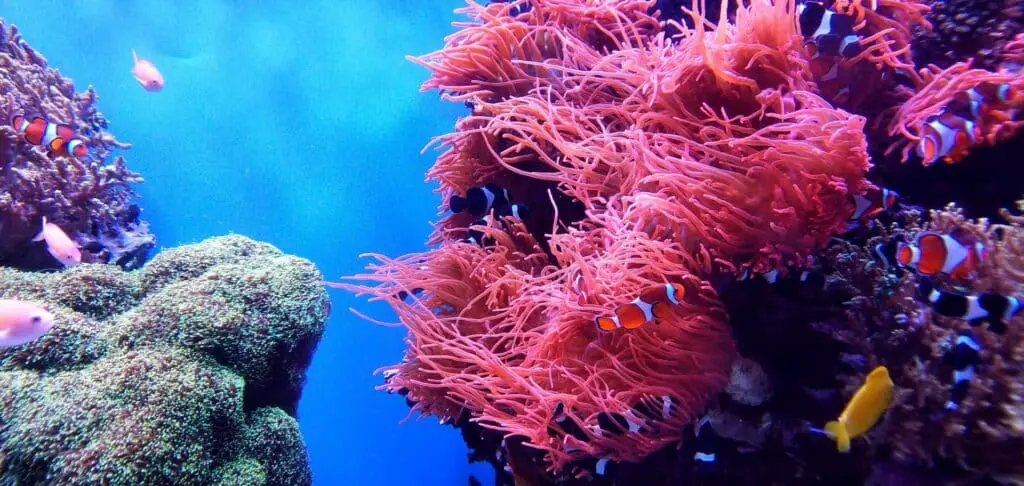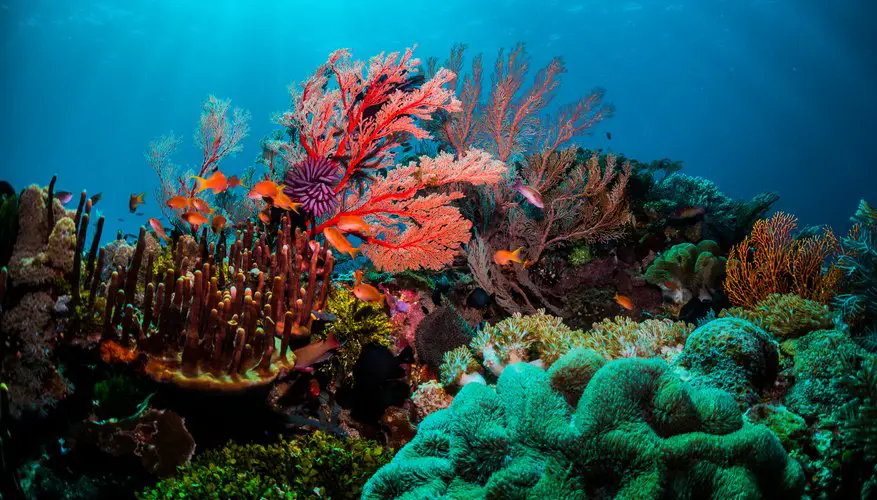What Is The Primary Food Source For Coral Reefs

Introduction
What Is The Primary Food Source For Coral Reefs: Coral reefs, often referred to as the “rainforests of the sea,” are among the most biologically diverse ecosystems on our planet. These vibrant underwater communities are teeming with life, from the dazzling corals themselves to the myriad of fish, crustaceans, and other marine creatures that call them home. However, sustaining this remarkable biodiversity requires a primary food source that serves as the foundation of the entire coral reef ecosystem.
The primary food source for coral reefs primarily consists of two key components: plankton and algae. Plankton are microscopic organisms that drift with ocean currents, and they play a crucial role in the marine food web. Coral polyps, the tiny organisms that build the calcium carbonate skeletons of coral reefs, rely on plankton as their primary source of sustenance.
Algae, on the other hand, provides another essential food source for coral reefs. Many species of corals engage in a symbiotic relationship with types of algae called zooxanthellae. These algae live within the coral tissues and photosynthesize, converting sunlight into energy-rich compounds that benefit both the coral and the algae themselves.
The combination of plankton and algae sustains the intricate and delicate balance of life within coral reef ecosystems. However, this delicate equilibrium is increasingly threatened by climate change, pollution, and other human-induced stressors, underscoring the urgent need for their conservation and protection.

What is the best food for coral reefs?
LPS corals along with colonial polyps typically have larger mouths so they can easily consume pellet or frozen foods such as brine and mysis shrimp. Many soft corals and SPS corals have much smaller mouths and will require liquid or powder foods with smaller particles.
The best food for coral reefs consists of a diverse array of plankton and algae. These essential components provide the necessary nutrients to sustain the delicate balance of life within these vibrant marine ecosystems.
- Plankton: Plankton serves as a primary food source for many coral species. Zooplankton, tiny animal organisms, and phytoplankton, microscopic plant-like organisms, are crucial for coral nutrition.
- Algae: Algae, especially the symbiotic zooxanthellae, play a vital role in coral nutrition. These single-celled algae live within the coral tissues and engage in a mutually beneficial relationship. They perform photosynthesis, converting sunlight into energy-rich compounds, which they share with the coral.
- Marine Debris Reduction: While plankton and algae are the natural food sources for coral reefs, reducing marine debris and pollution is equally important. Pollution can disrupt the balance of nutrients and harm coral health. Practices like responsible tourism and sustainable fishing can help mitigate pollution and physical damage to coral reefs.
To preserve and protect these invaluable ecosystems, it is crucial to reduce stressors like climate change, pollution, and overfishing. By maintaining the health of their primary food sources and addressing external threats, we can contribute to the survival and well-being of coral reefs around the world.
What is a primary consumer in a coral reef?
The Primary Consumers – the coral, sea turtle, and fish. The Secondary Consumers – the sharks, anemones, starfish, baracuda, jellyfish, sea snakes and sea slugs. The Scavengers – the fish.
A primary consumer in a coral reef ecosystem plays a pivotal role in the intricate web of marine life. These organisms, often referred to as herbivores or grazers, are the first tier in the food chain within the vibrant coral reef community. Primary consumers are typically small fish, crustaceans, and invertebrates that primarily feed on algae, plankton, and detritus.
One of the key functions of primary consumers is to control algae growth on coral reefs. They graze on the algae that can otherwise smother and harm the delicate coral structures. By doing so, they help maintain a healthy balance between corals and algae, ensuring the continued growth and vitality of the reef.
Additionally, primary consumers serve as a critical energy transfer point between primary producers (such as algae and phytoplankton) and higher-level consumers (predatory fish and larger marine species). They channel the energy from photosynthetic organisms into the reef’s food chain, making it accessible to other marine life forms.
In essence, primary consumers are the foundation of the coral reef food web, supporting the diversity and complexity of this remarkable ecosystem while playing a crucial role in its overall health and stability.
How is coral a source of food?
Coral reefs provide food to millions of humans.
Corals, like trees, provide three-dimensional structure and substrate to house and feed fish and other marine animals that humans eat.
Coral itself is not a source of food for humans or most marine organisms, but rather, making them indirectly crucial as a source of food. Here’s how coral reefs function as a source of food within marine ecosystems:
- Fish and Invertebrates: Coral reefs are teeming with diverse fish species and invertebrates, many of which serve as a source of food for both human and predatory marine species. These fish and invertebrates find shelter and food amidst the coral structures, using the reefs as their primary habitat.
- Predatory Species: Coral reefs attract larger predatory species such as sharks, barracudas, and jacks. These predators, in turn, feed on the smaller fish and invertebrates that inhabit the reef, creating a complex food chain.
- Algae and Plankton: Coral reefs support a variety of algae and phytoplankton. These primary producers are a food source for herbivorous fish and invertebrates, which, in turn, become prey for larger carnivorous species.
- Reef-Associated Species: Some marine species, like sea cucumbers and certain snails, directly consume coral or the algae that grow on it. These species are adapted to feed on the live or dead coral tissue.
Coral reefs act as a critical foundation for marine ecosystems by providing a habitat for a wide range of species, many of which are a source of food for other marine organisms, including humans. The health and abundance of these reefs are essential for supporting fisheries and maintaining biodiversity in the oceans.
What food are made from coral reefs?
From the coveted bluefin tuna to the more accessible edible algae such as sea grapes, aquatic foods contribute to nutritional security, are a source of micronutrients, and can be a shelf-stable, fresh, or frozen source of protein. Around 25% of known marine organisms depend on coral reefs as habitats.
Coral reefs, the vibrant and diverse underwater ecosystems, do not directly serve as ingredients for human consumption. Instead, they play a crucial role in supporting the marine food web, indirectly providing sustenance for various species of fish and seafood that ultimately end up on our plates.
Coral reefs offer a habitat for numerous marine creatures, including fish like grouper, snapper, and parrotfish. These fish find shelter and food within the reef’s complex structures. Additionally, the abundance of plankton around coral reefs attracts small herbivorous fish, which are part of the diet of larger carnivorous fish. The coral reef ecosystem, therefore, contributes to the overall productivity of the ocean, sustaining a variety of fish populations that are commercially harvested for human consumption.
Indirectly, coral reefs also support the livelihoods of communities that rely on fishing for their sustenance and income. Healthy reefs help maintain fish populations, ensuring a consistent source of seafood for these coastal communities.
While coral reefs themselves are not consumed as food, they are essential for the production of various seafood species that make their way onto our dinner plates, highlighting the critical need for the conservation and preservation of these fragile marine ecosystems.
What is the primary food source for most corals?
Algae
Corals get their food from algae living in their tissues or by capturing and digesting prey. Most reef-building corals have a unique partnership with tiny algae called zooxanthellae. The algae live within the coral polyps, using sunlight to make sugar for energy.
The primary food source for most corals is not what you might expect. While they are often mistaken for plants due to their appearance, corals are actually animals. They are classified as cnidarians, which are invertebrates related to jellyfish and sea anemones. Corals rely on a unique and mutually beneficial relationship with tiny photosynthetic organisms known as zooxanthellae, which are a type of dinoflagellate algae.
Zooxanthellae live within the tissues of coral polyps, the individual coral animals. Through a process called photosynthesis, these algae convert sunlight into energy and produce sugars and other organic compounds. They share some of these nutrients with the coral host in exchange for a protected environment and access to nutrients produced by the coral.
While zooxanthellae provide the primary source of nutrition for corals, they also capture small planktonic organisms and microscopic particles from the surrounding water using their tentacles and specialized stinging cells called nematocysts. This supplementary feeding allows corals to obtain additional nutrients when the availability of zooxanthellae-produced food is limited, such as during periods of high water temperatures or low light conditions.
How do people rely on coral reefs as their main source of food?
Coral reefs support 6 million fishers in nearly 100 countries. Reefs account for 10-12% of the fish caught in tropical countries, and 20-25% of the fish caught by developing nations. They are a primary source of food and protein for many coastal communities.
Coral reefs serve as crucial ecosystems for coastal communities around the world, providing sustenance for millions of people who depend on them as their primary source of food. These vibrant underwater habitats support an immense biodiversity, harboring an array of fish, shellfish, and other marine organisms. For many coastal communities, particularly in developing regions of Southeast Asia, the Caribbean, and the Pacific Islands, the bounty of coral reefs represents a fundamental aspect of their diet.
Local fishing communities rely on these reefs for a diverse range of seafood, including fish like snapper and grouper, as well as mollusks such as clams and mussels. Additionally, the rich biodiversity of coral reefs offers a variety of nutritional options, essential for maintaining balanced diets. For inhabitants of these coastal areas, fishing on the reefs is often not just an economic activity, but a cultural tradition passed down through generations.
However, this delicate balance is under increasing threat due to human activities like overfishing, pollution, and climate change. Destructive fishing practices and rising sea temperatures contribute to the degradation of coral reefs, jeopardizing the livelihoods and food security of those who depend on them. It is imperative that we take concerted efforts to preserve and protect these invaluable marine ecosystems, ensuring they continue to serve as vital sources of sustenance for generations to come.
Which are the most important primary producers in a coral reef?
Reef-building corals and algae are the most abundant primary producers on coral reefs, and I use coarse functional groupings categorized as reef-building corals, fleshy macroalgae, calcareous macroalgae, crustose coralline algae (CCA) and turf algae assemblages.
In a coral reef ecosystem, the most vital primary producers are the symbiotic algae known as zooxanthellae and the various types of phytoplankton. These microscopic organisms play a foundational role in the reef’s food chain and overall ecological balance.
Zooxanthellae are single-celled algae that form a mutualistic relationship with coral polyps. They reside within the tissues of the coral and utilize photosynthesis to convert sunlight into energy, providing a significant portion of the coral’s nutritional needs. In return, the coral offers protection and a stable environment for the zooxanthellae to thrive. This unique symbiosis is what gives coral reefs their vibrant colors.
Phytoplankton are free-floating, microscopic plants that drift in the water column. They are essential primary producers in coral reef ecosystems, providing a source of sustenance for various marine organisms, including small fish and invertebrates. Phytoplankton are not only a direct food source for many reef inhabitants but also play a crucial role in oxygen production and carbon cycling within the ecosystem.
These primary producers form the cornerstone of the intricate food web in coral reefs, supporting a diverse array of marine life. Their health and abundance are critical for the overall well-being and resilience of these fragile but vital underwater ecosystems.
What will coral eat?
Corals are fascinating creatures, but they don’t eat in the way animals with mouths and digestive systems do. Instead, they have a unique relationship with tiny, single-celled algae called zooxanthellae. These algae live inside the coral’s tissues and harness sunlight through photosynthesis to produce sugars and other nutrients.
In return for shelter and protection, the zooxanthellae share some of these nutrients with the coral, providing them with a substantial portion of their energy needs. This symbiotic relationship is crucial for the survival and growth of coral reefs.
Aside from their reliance on zooxanthellae, corals also have specialized cells called nematocysts that allow them to capture and consume small planktonic organisms. These include tiny creatures like zooplankton and small fish larvae. When these organisms come into contact with the stinging tentacles of the coral, the nematocysts release venom to immobilize and digest the prey.
It’s important to note that while corals can capture and consume plankton, their primary source of sustenance comes from the photosynthetic activity of the zooxanthellae. This unique feeding mechanism makes corals highly sensitive to changes in water temperature, light, and nutrient levels, making them particularly vulnerable to environmental stressors like pollution and climate change.

Conclusion
The primary food sources for coral reefs, namely plankton and algae, are the lifeblood of these extraordinary marine ecosystems. Algae, particularly the symbiotic zooxanthellae, play a pivotal role by supplying corals with energy derived from photosynthesis.
These food sources form the cornerstone of coral reef ecosystems, supporting a dazzling array of marine life, from colorful corals to diverse fish species. However, these fragile ecosystems are under siege from multiple threats, including rising sea temperatures, ocean acidification, pollution, and destructive fishing practices.
To safeguard the future of coral reefs, it is imperative that we address these threats and work diligently to reduce our carbon footprint to mitigate climate change. Moreover, responsible tourism and conservation efforts can help protect coral reefs from physical damage and contamination. Scientific research and monitoring are vital to understanding and managing these ecosystems effectively.
The fate of coral reefs is interconnected with our planet’s overall health, and preserving them is not just a matter of ecological importance but a global imperative. By recognizing the primary food sources of coral reefs and understanding their vulnerabilities, we can take meaningful steps to ensure the survival and thriving of these breathtaking underwater wonders for generations to come. It is a shared responsibility to protect and conserve these invaluable treasures of our oceans.



